In the realm of remarkable interior design, the essence lies in weaving together functional elements such as optimized spaces and adaptable layouts, harmonizing color schemes and captivating lighting effects, and meticulously crafting spatial layouts that enhance flow and aesthetic appeal. The interplay of texture and contrast adds depth and character to the space, while decorative elements personalize and evoke emotional engagement. Balancing elements and creating focal points enhance visual coherence and artistic expression, embracing natural and sustainable elements for tranquility and well-being. Stimulating sensory experiences and nurturing personal connections form the heart of exceptional interior design, inviting you to explore further.
Key Takeaways
- Functional Elements ensure practicality and elegance.
- Harmony in Color and Lighting sets the mood.
- Efficient Spatial Layout enhances flow and appeal.
- Texture and Contrast add depth and interest.
- Personalization and Emotional Engagement create a unique experience.
Functional Elements

Exploring the realm of interior design, one can't overlook the crucial role played by functional elements in shaping a space.
Space optimization is key, blending practical aesthetics with a user-centric approach. When considering multi-functional design, ergonomic considerations are paramount to ensure comfort and efficiency.
Adaptable layouts cater to varied needs, promoting versatility within a room. Storage solutions merge seamlessly with zoning techniques, allowing for both organization and visual appeal.
Applying minimalist principles fosters a sense of simplicity and sophistication, leading to a harmonious environment.
Color Harmony
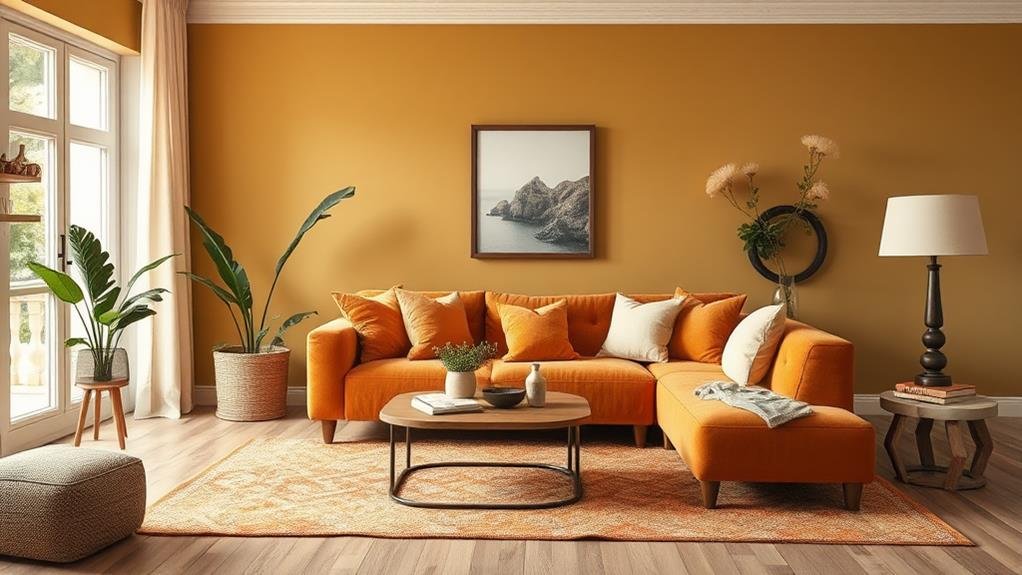
Welcome to the colorful world of interior design!
When it comes to creating a harmonious space, color schemes take the spotlight. To achieve a cohesive look, remember that coordination is key – from the walls to the furniture and decor, every shade plays a vital role in setting the mood of your room.
Focus on Color Schemes
When creating a harmonious color scheme for your interior design, it's essential to consider the impact that colors have on the overall ambiance of a space.
Color psychology plays a crucial role in setting the mood of a room. Seasonal palettes can evoke different feelings, with warm tones bringing coziness in winter and bright hues infusing energy in summer. Cultural influences also shape our color preferences, reflecting traditions and beliefs. By understanding color trends, you can stay attuned to contemporary styles while expressing your individuality.
Emotional responses to color vary widely; therefore, incorporating accent colors strategically can enhance specific feelings within a room.
Monochromatic schemes create a sense of elegance and unity, while complementary colors provide a dynamic contrast. Experimenting with color blocking can add a modern twist, creating visual interest and depth.
Ultimately, mastering color harmony in your interior design involves a delicate balance of these elements to craft a space that truly resonates with your personality and style.
Coordination Is Key
Consider the artful dance of colors in your living space – a symphony where each hue performs in perfect harmony with the others. Achieving color coordination is not just about picking a palette; it is about creating design cohesion and style consistency. Your space should exude aesthetic unity and have theme alignment to make it visually appealing. Element integration and pattern synchronization play key roles in establishing visual rhythm that enhances the overall mood of the room. Structural harmony is crucial in ensuring that every color choice fits seamlessly into the design puzzle, elevating the space to new heights.
To help you visualize this concept, here is a table showcasing the importance of color coordination in interior design:
| Key Aspects | Description |
|---|---|
| Design Cohesion | Ensuring all colors work together. |
| Style Consistency | Maintaining a coherent look throughout. |
| Aesthetic Unity | Creating a visually pleasing space. |
| Theme Alignment | Ensuring colors align with the overall theme. |
Lighting Effects
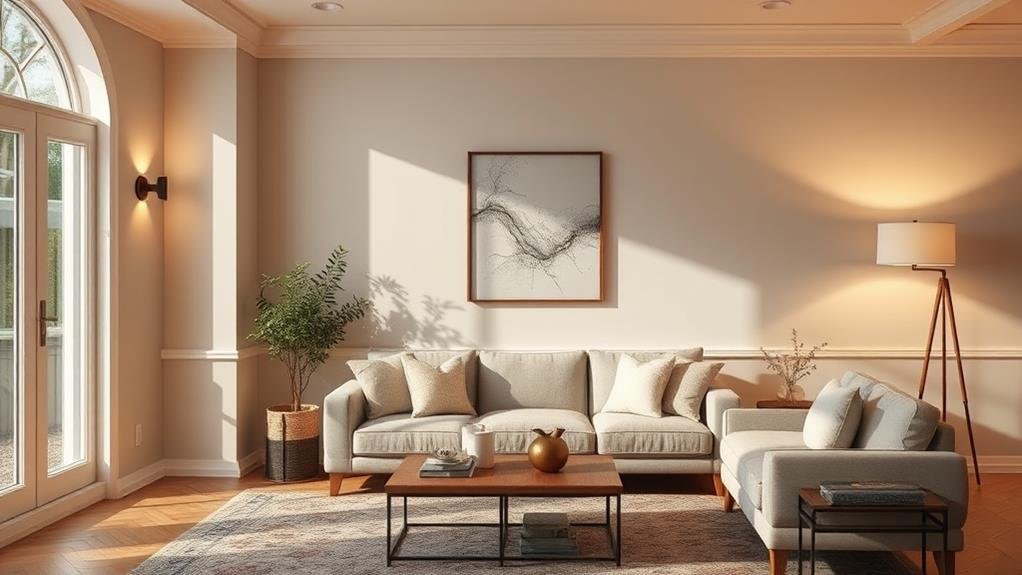
Creating captivating lighting effects in interior design can transform a space into a spectacle that plays with mood and ambiance. Achieving this involves a thoughtful combination of ambient lighting, task lighting, and accent lighting.
Consider the color temperature of your light sources to create different atmospheres – warmer hues for a cozy feel and cooler tones for a more energetic vibe. Utilize various lighting fixtures strategically to enhance design aesthetics – from elegant chandeliers to sleek recessed lights.
Don't underestimate the power of natural light, which adds a refreshing touch and connects the interior with the outdoors.
Embrace layered lighting to provide flexibility in setting different moods throughout the day. Aim for energy efficiency by incorporating LED bulbs and automated lighting controls.
Textural Contrast
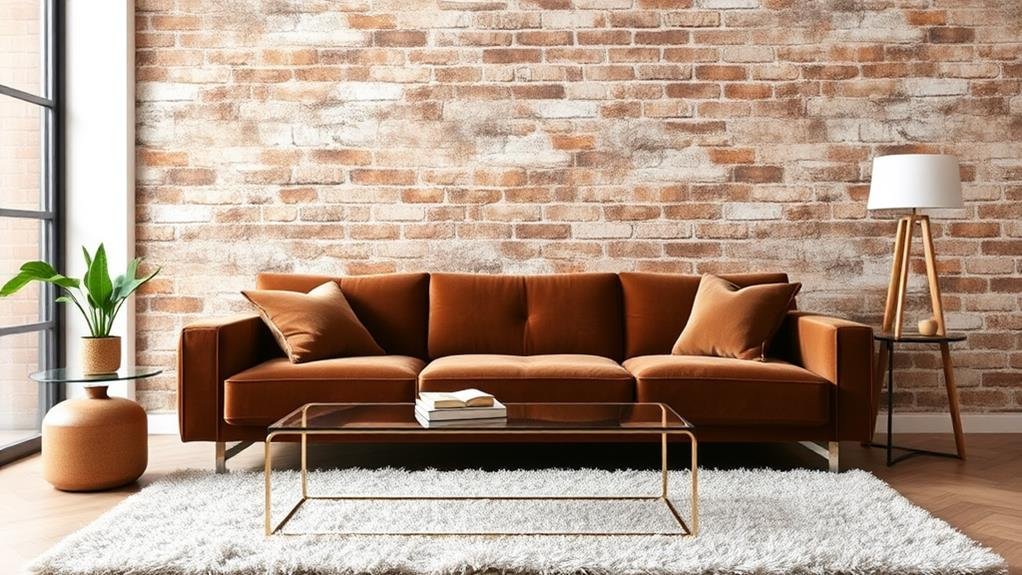
Texture is a powerful element in interior design, adding depth and character to a space like no other attribute can. When it comes to creating a visually appealing and engaging interior, textural contrast plays a crucial role. By incorporating various textures, you can enhance the sensory engagement of a room, offering a rich experience to both the eyes and the fingertips. Textural layering through different material choices, contrasting finishes, fabric combinations, and surface variations can elevate the overall feel of a space, creating depth perception and visual interest.
| Textural Contrast | Examples |
|---|---|
| Smooth vs. Rough | Wood and Metal |
| Soft vs. Hard | Velvet and Glass |
| Shiny vs. Matte | Glossy Ceramic Tiles |
| Patterned vs. Plain | Striped Wallpaper |
| Coarse vs. Fine | Wicker and Silk fabric |
Spatial Layout
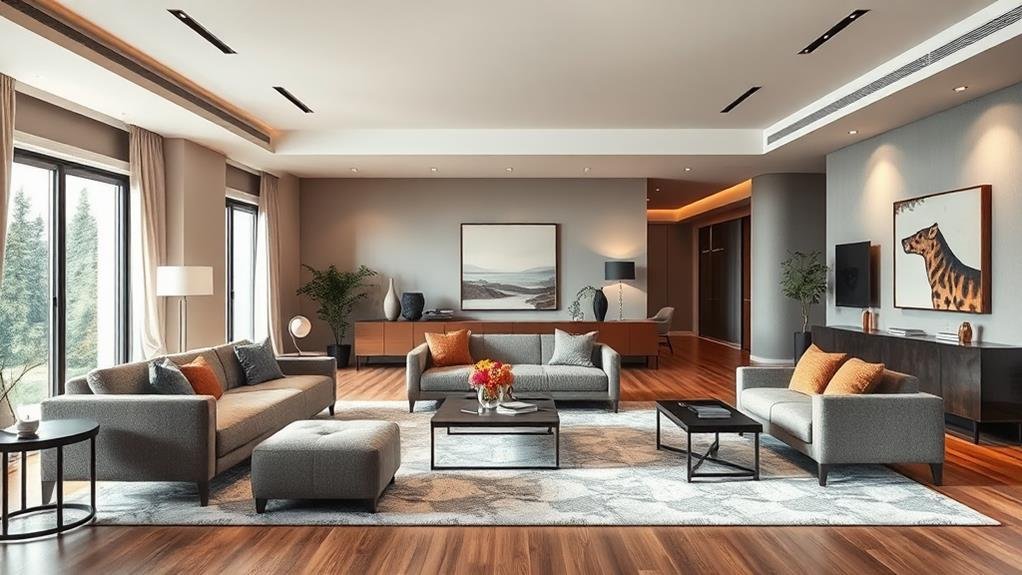
Picture this: your living room seamlessly transitioning into your dining area, creating an undisturbed flow throughout your home.
Efficient room flow isn't just about moving from one space to another, but ensuring that each area complements the next.
Functional furniture arrangement plays a key role in achieving this harmony, maximizing both style and practicality within your space.
Efficient Room Flow
Navigating through a space effortlessly is a key aspect of interior design that can greatly enhance the functionality and aesthetic appeal of a room. Efficient room flow isn't just about moving from point A to point B, but also about creating a seamless experience throughout the space.
By carefully considering open spaces, movement patterns, and clear pathways, you can optimize traffic flow and enhance spatial awareness.
- Open Spaces: Incorporating open spaces in your design allows for a sense of freedom and airiness. It creates breathing room and prevents the area from feeling overcrowded.
- Movement Patterns: Designing with movement patterns in mind ensures that individuals can move around the room with ease and without obstacles hindering their path.
- Clear Pathways: Establishing clear pathways helps guide people through the space, keeping them oriented and enhancing the overall flow of the room.
Functional Furniture Arrangement
Considering effective spatial layout in your interior design is like crafting a symphony of functionality and aesthetics. To achieve this harmonious blend, focus on space optimization, furniture selection, and multi-functional designs.
Start by strategizing arrangement techniques and zoning areas for specific purposes. Aesthetic functionality should drive your choices, balancing scale considerations with user experience. Comfort factors play a crucial role in determining the success of the layout, influencing circulation patterns throughout the space.
When selecting furniture, keep in mind the dual importance of both form and function. Opt for pieces that not only look good but also serve a practical purpose.
Experiment with different layouts to find what works best for your specific space while enhancing the overall design. By prioritizing functional furniture arrangement, you'll create an interior that not only looks great but also feels inviting and cohesive.
Decorative Accents
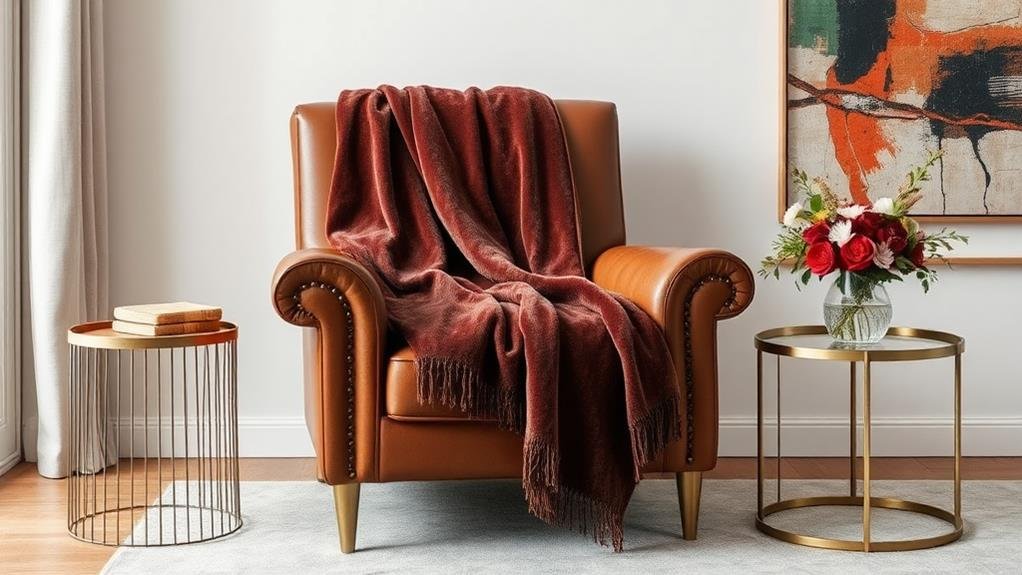
When it comes to designing a space, Decorative Accents play a crucial role in adding personality and style to your interior.
These touches can transform a room from mere functionality to a space that speaks volumes about your taste and individuality. To elevate your interior design, consider incorporating:
- Cultural Influences: Infuse your space with elements from around the world, such as vibrant textiles, intricate patterns, or symbolic decor pieces that reflect your heritage or simply spark intrigue.
- Handcrafted Items: Introduce a sense of craftsmanship and uniqueness through handcrafted pottery, woven baskets, or artisanal sculptures that add a touch of authenticity and warmth.
- Layered Decor: Experiment with layering different textures, colors, and shapes by combining various elements like throw pillows, rugs, and wall art to create depth and visual interest in your space.
These decorative accents not only enhance the aesthetic appeal but also contribute to the overall ambiance and charm of your home.
Personalized Touches
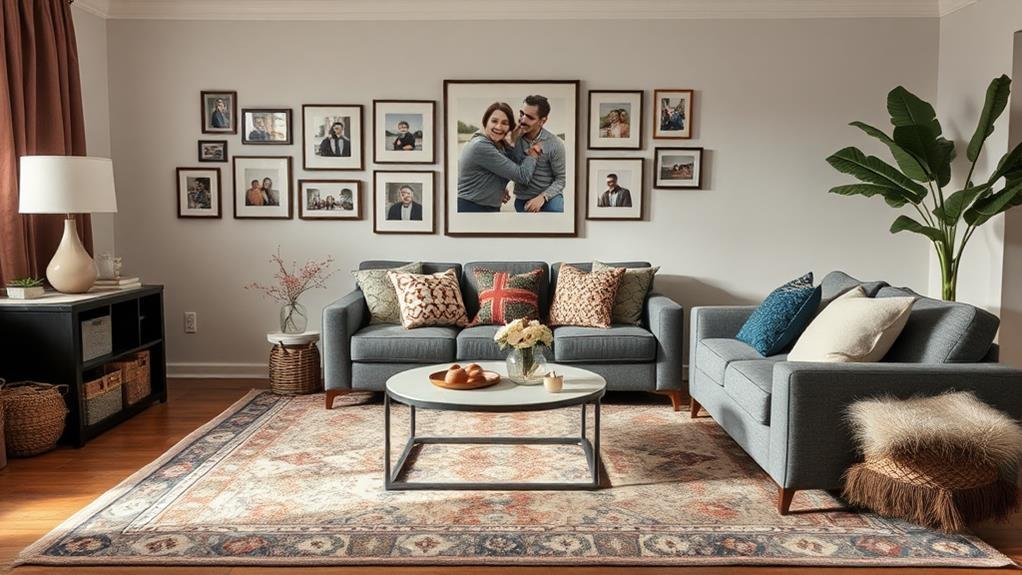
Adding personalized touches to your interior design not only showcases your individuality but also creates a space that truly feels like home. Infusing your space with unique artwork, meaningful mementos, and personalized decor allows you to express your personality in a tangible and visually striking way.
Consider integrating custom furnishings, family heirlooms, or items reflecting cultural influences to add depth and warmth to your interiors. Sharing personal stories through sentimental objects can evoke cherished memories and create a welcoming atmosphere that's uniquely yours.
Tailoring your designs to include these personalized elements ensures that your space reflects your individual expression and creates a sense of belonging.
Whether it's a gallery wall showcasing your favorite artwork or incorporating family heirlooms into the decor, these personalized touches elevate your interior design from mere aesthetics to a narrative of your life and experiences.
Embrace the power of tailored designs to transform your living spaces into a reflection of your true self.
Balance & Symmetry
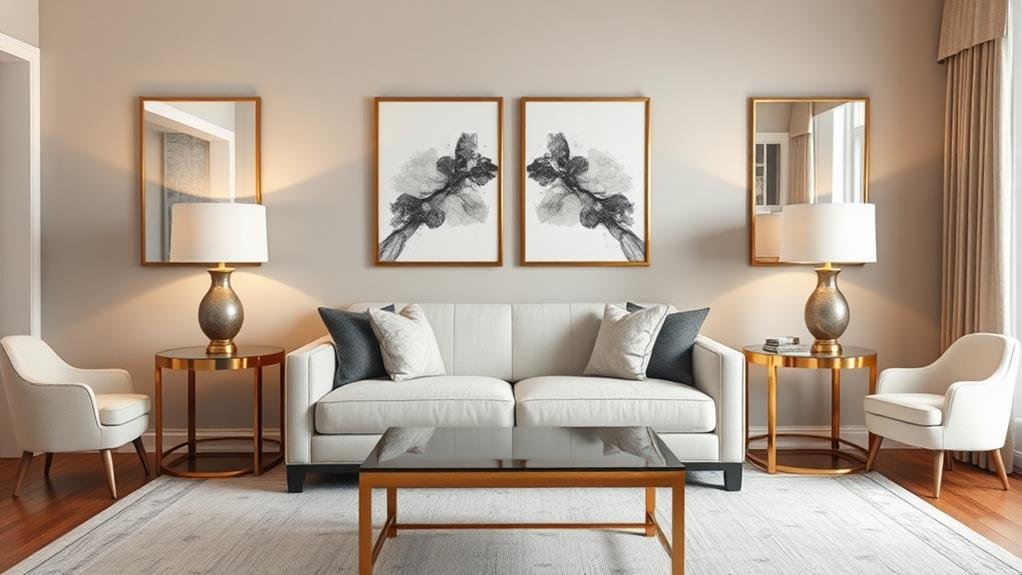
When it comes to balancing and symmetry in interior design, harmonious visual elements play a crucial role in creating a cohesive and pleasing environment.
Achieving equilibrium in layout ensures that each piece in the space complements and enhances the overall aesthetic.
Utilizing symmetry can further enhance the flow and harmony of a room, creating a sense of unity and sophistication.
Harmonious Visual Elements
For a visually striking interior design, achieving harmonious visual elements like balance and symmetry is essential.
When designing your space, consider these key aspects to create a cohesive style:
- Visual Balance: Balance the visual weight of furniture, decor, and colors to establish a sense of equilibrium throughout the room.
- Aesthetic Unity: Strive for a harmonious blend of elements to ensure a unified and pleasing aesthetic that reflects your personal style.
- Proportionate Elements: Maintain proportion in the sizes and placement of furniture and decorations to create a sense of visual harmony and coherence.
Equilibrium in Layout
In achieving a layout that exudes equilibrium, focusing on the principles of balance and symmetry becomes pivotal.
Design balance plays a crucial role in creating spatial harmony within a room, ensuring that elements interact in a way that feels visually appealing. By considering proportion principles, you can manage the visual weight of different components, maintaining a sense of equilibrium.
Axis alignment helps in establishing a structured layout that feels coherent and intentional, while negative space offers areas of rest within the design.
Design rhythm and flow patterns contribute to the overall dynamics of the layout, guiding the eye smoothly through the space. Scale considerations are also essential to ensure that each element fits harmoniously within the composition, maintaining a sense of balance.
Embracing these principles of equilibrium in your layout won't only enhance the aesthetic appeal of the design but also create a cohesive and inviting environment.
Symmetry for Cohesion
To create a sense of cohesion in your interior design layout, symmetry stands as a key element that brings balance and order to the space. Symmetrical design not only provides visual harmony but also helps distribute visual weight evenly throughout the room.
Imagine walking into a room where everything feels perfectly balanced and visually pleasing. Symmetry achieves this by mirroring elements on either side of an imaginary axis, creating a pleasing sense of equilibrium.
- Mirror, Mirror: Reflective surfaces like mirrors or polished furniture pieces can enhance symmetry in a room, doubling the impact of key design elements.
- Perfect Pairs: Use pairs of identical or similar items, such as matching lamps or chairs, to create a cohesive and symmetrical look that exudes elegance.
- Focal Point: Anchoring the room with a central focal point, like a statement piece of art or furniture, can serve as the axis around which the rest of the design elements can be symmetrically arranged.
Focal Points
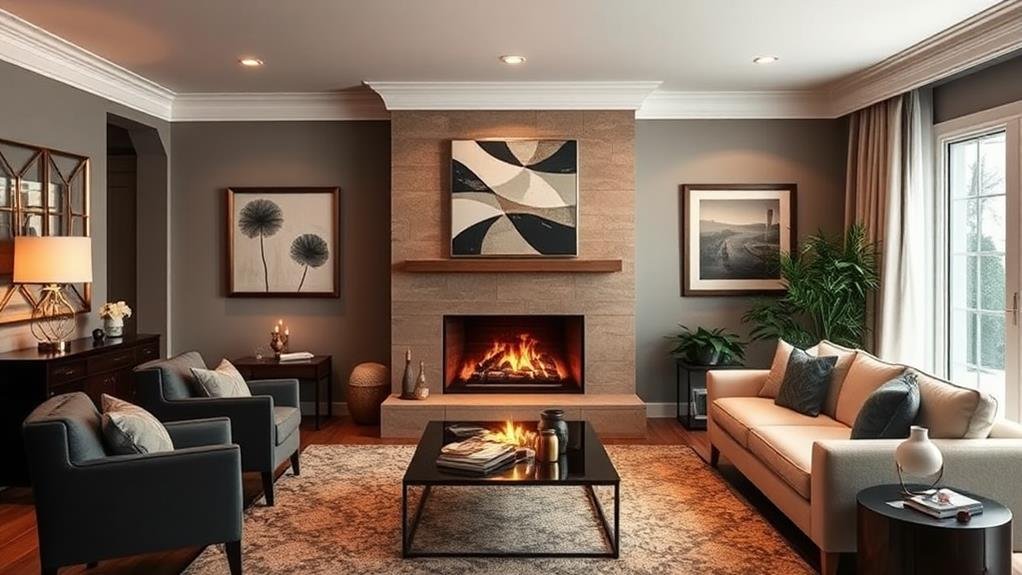
Positioned strategically within a space, focal points serve as captivating elements that draw the eye and anchor the design scheme. When creating your interior, consider using focal points as a means of artistic expression and visual storytelling, reflecting your personal style while incorporating cultural influences.
Embracing seasonal themes can infuse life into your space, while integrating architectural elements can add historical context. For those drawn to a minimalist approach, a single bold statement piece can serve as a powerful focal point. Alternatively, explore layered aesthetics by combining multiple elements to create an intricate focal point that tells a story within your space.
Whether it's a striking piece of art, a unique architectural feature, or a carefully curated collection, focal points play a vital role in shaping the ambiance and personality of a room. Experiment with different focal points to see how they transform your space and evoke a sense of visual interest and harmony.
Natural Elements
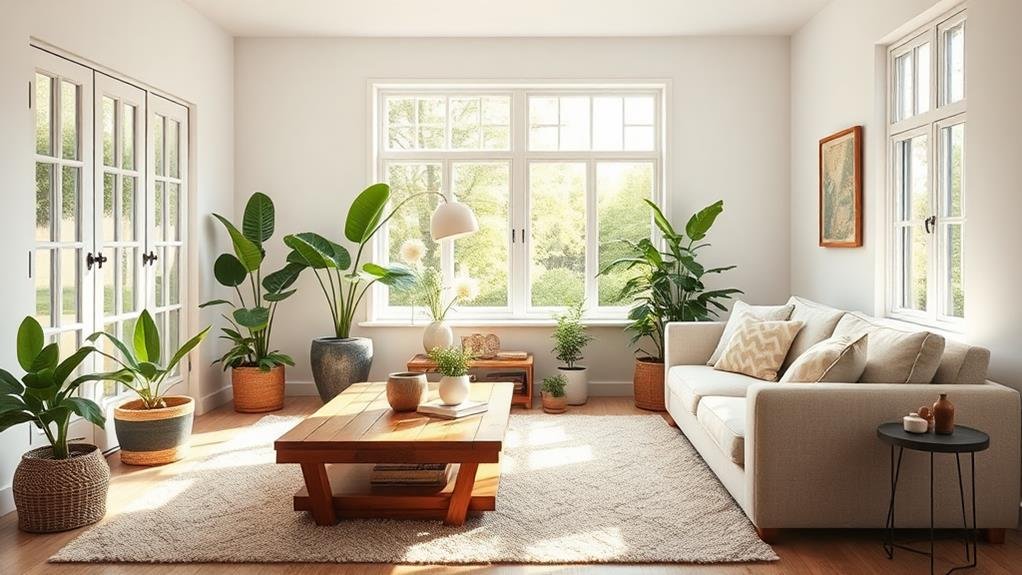
Elevate your interior design with the inclusion of natural elements, infusing your space with the beauty and serenity of the outdoors.
Embracing biophilic design principles can create a harmonious environment that promotes well-being and connection to nature.
Consider these elements to transform your space:
- Indoor Plants: Introduce lush greenery into your home to purify the air and add a touch of nature's tranquility.
- Texture Variety: Incorporate organic materials like wood, stone, or rattan to bring warmth and richness to your living spaces.
- Natural Light: Maximize daylight exposure to create an airy and inviting atmosphere that mimics the changing light patterns of the outdoors.
Sustainable Practices
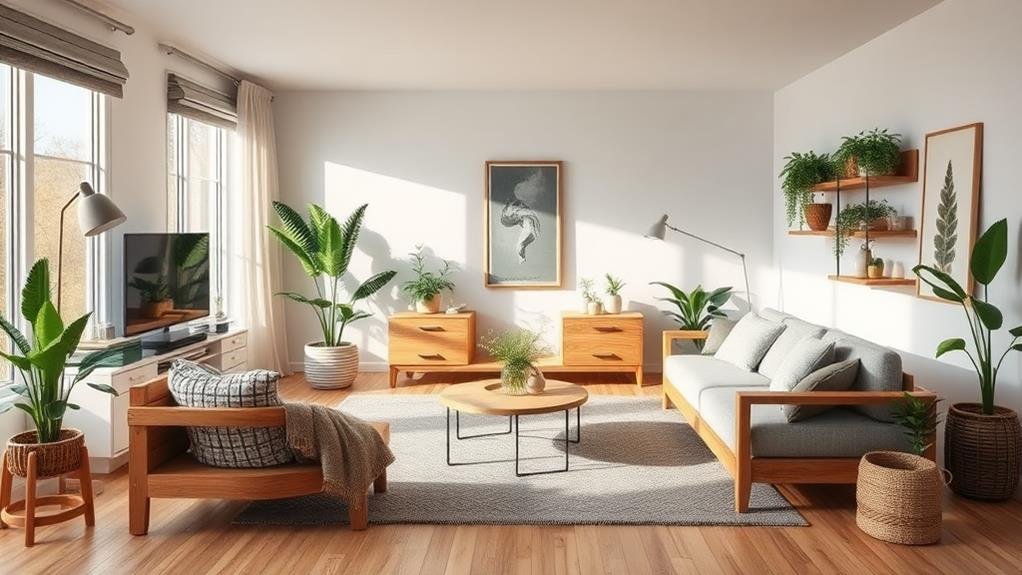
By incorporating sustainable practices into your interior design, you can make a meaningful impact on both the environment and your living space. Utilizing eco-friendly materials, such as organic textiles and upcycled furniture, not only adds a unique touch to your décor but also reduces the strain on the planet's resources.
Energy efficiency is key, with passive design techniques helping to regulate temperatures and reduce the need for excessive heating or cooling.
Embrace biophilic design by incorporating elements of nature into your home, fostering a connection with the outdoors. Implement zero waste strategies to minimize the environmental footprint of your design choices.
Opt for sustainable sourcing from local artisans to support small businesses and reduce transportation emissions. Look for green certifications when selecting products to ensure they meet the highest environmental standards.
Incorporating sustainable practices not only creates a stylish and inviting space but also aligns with your values as a conscious consumer.
Make a positive impact through thoughtful choices that prioritize both style and sustainability.
Emotional Impact
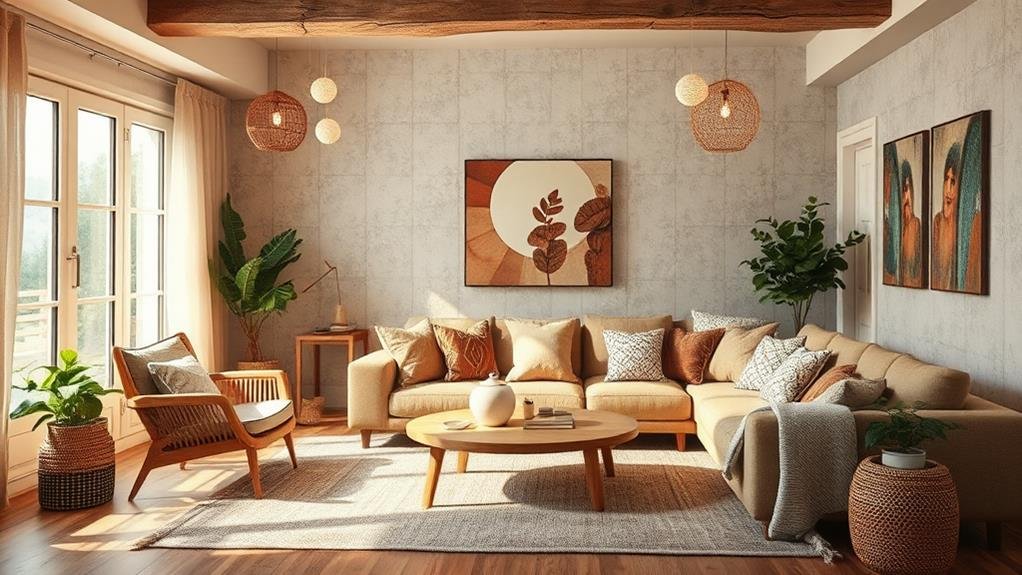
To truly understand the essence of interior design, one must delve into the realm of its emotional impact – the subtle yet profound way in which your surroundings can shape your mood, mindset, and well-being.
Interior design goes beyond just aesthetics; it has the power to evoke emotional storytelling and create a space filled with personal connections and nostalgic elements.
The atmosphere within a designed space can evoke spatial emotions, enhancing your mood and providing psychological comfort in ways you may not even realize.
Here's how interior design can impact your emotions:
- Engaging sensory experiences that stimulate your senses and elevate your mood
- Building personal connections through thoughtful design elements that resonate with your individuality
- Crafting an atmosphere that nurtures psychological comfort and stirs nostalgic feelings, enveloping you in warmth and familiarity.
Conclusion
As you reflect on the various elements that make up a great interior design, remember that the essence lies in creating a space that not only looks beautiful, but also functions efficiently and evokes emotion. By incorporating color harmony, lighting effects, textural contrast, and natural elements, you can create a space that is not only visually pleasing, but also sustainable and emotionally impactful. So go ahead, design with purpose and let your creativity shine through every corner of your space.

